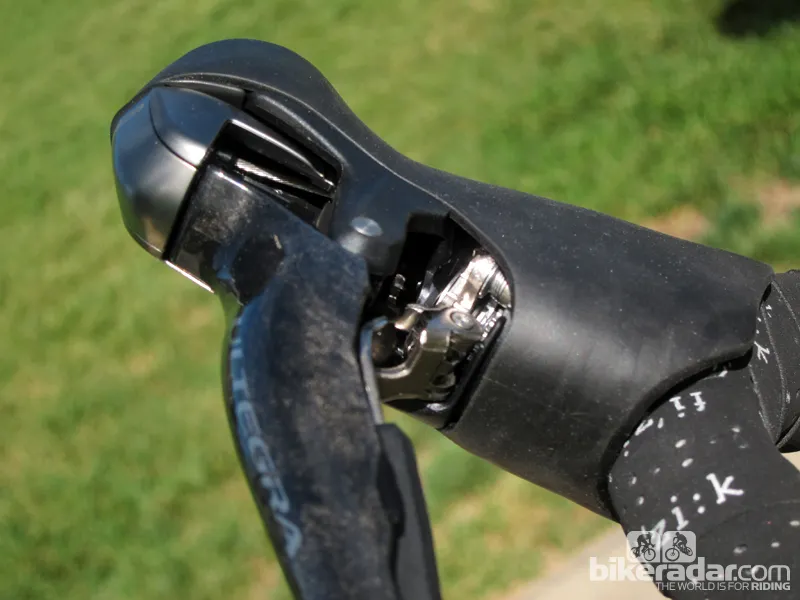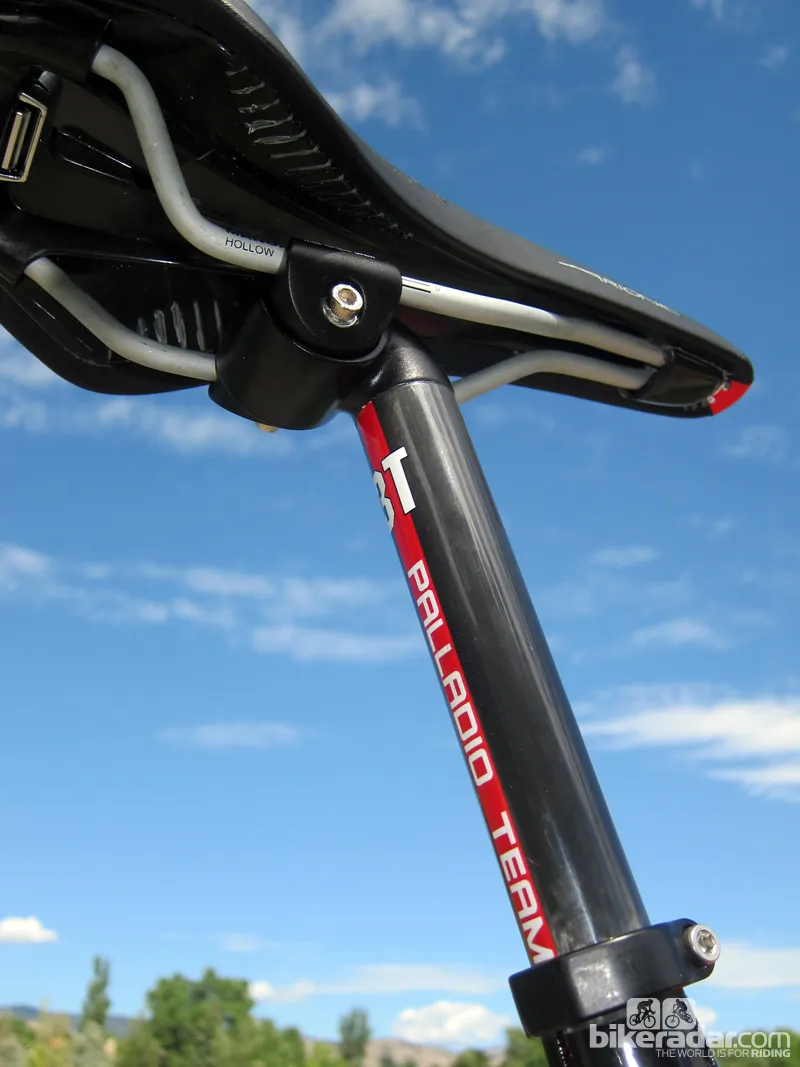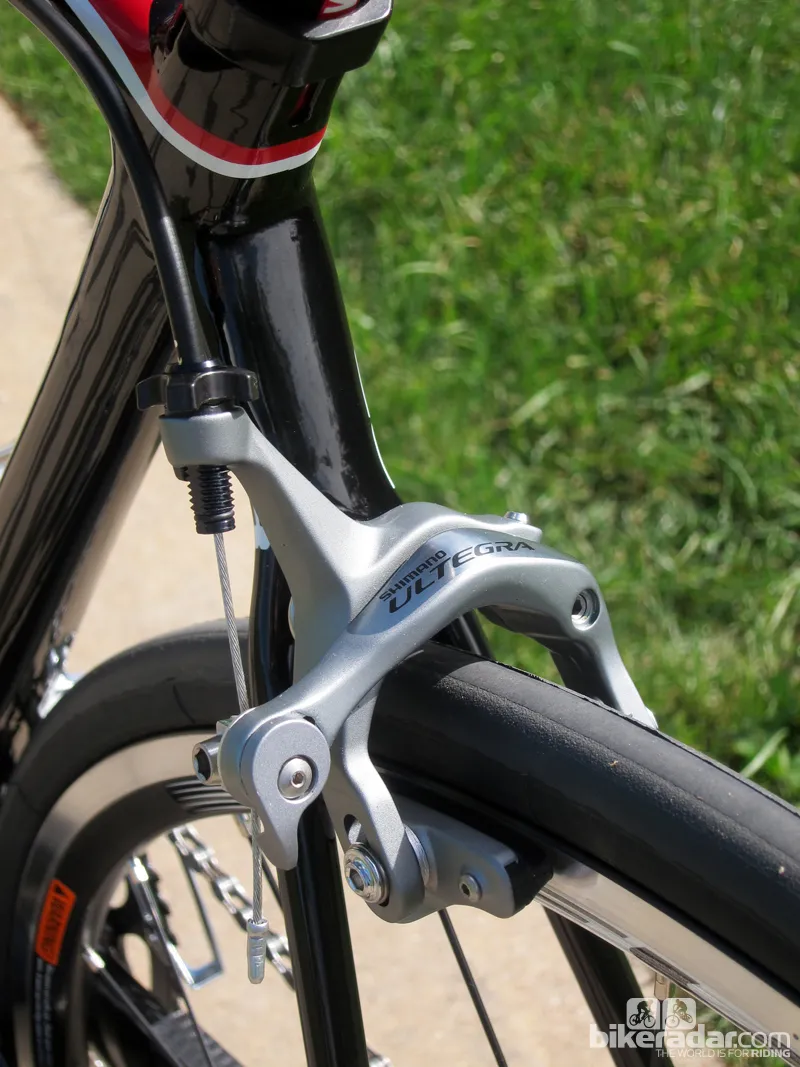Cervélo's original R3 and R3-SL chassis of yesteryear were expensive, aspirational objects, and rightfully so with their enviably brilliant mix of efficiency and ride quality.
The latest mid-range R3 Team retains the design philosophy but has a slightly cheaper carbon fiber blend, to lower the cost of entry, and a more refined geometry. It doesn't feel quite as magical as it used to.
Ride & handling: Light chassis but not especially stiff or smooth
The Cervélo R3 series has long been one of the hallmarks of the 'stiff and light yet comfortable' group of road bikes. For the most part, the mid-range Team makes good on the pedigree.
It's admirably efficient both in terms of power transfer and handling inputs, making for great acceleration when you hammer the pedals and precise turns when the going gets twisty. It's also quite light, with an actual frame weight of just 950g for our 51cm test sample. And while the frameset makes no concessions to aerodynamics, Cervélo says it’s the best of the non-aero bikes it's tested.
Recent geometry updates have also made the latest R3 more confident in challenging, high-speed descents. Our Team felt impressively stable in a full tuck even at speeds topping 83km/h (52mph), where older examples – at least in the smaller sizes – could feel a little twitchy. The front end is still a touch nervous at more moderate speeds, with a very quick turn-in, but as long as you're not asleep at the wheel it's hardly unmanageable.
Visually speaking, Cervélo has continued with the R's engineering-driven aesthetics, with no crease, bend or bulge dedicated solely to appearances – heck, even the paint job is stark and simple. Riders seeking a more flamboyant machine will obviously want to look elsewhere but those more concerned with the numbers should be pretty satisfied.
That all being said, it's the more emotional aspects of the R3 Team's ride where we felt a little let down.
While the R3 Team is efficient, it's not blisteringly so, with a hint of hesitation when you really give it some gas. Likewise, it's not an overly engaging personality, with a somewhat numb feel and what seems like an overly muted ride on smaller amplitude features like road texture.
More surprising is that the R3 Team isn't as comfortable on bigger bumps as we expected, particularly given the legendary ride quality of earlier models. Whereas upper-end R3s we've tested have been eerily smooth on horrible Tarmac, this mid-range version transmits more high-amplitude harshness to your rear end.
In fairness, some of the ride quality and comfort issues can be partially attributed to Cervélo's disappointing choice in wheels and tires. We'll expand on this shortly, but suffice to say that the stock Fulcrum Racing T aluminum clinchers are stiff and heavy, and the Vittoria Rubino Pro Slick tires could use some major lessons in rolling resistance and casing flexibility. Swapping to a better-performing (but still reasonably priced) set of Easton EA90 Aero wheels and Continental Force/Attack tires helped enormously but even then we didn't get that 'electric' feel we so fondly remember.

The Fulcrum Racing T wheels really let the ride feel down – they're worth upgrading
Cervélo's senior advanced research and design engineer, Damon Rinard, insists there's nothing inherent to the frame to back up our experience, though.
"The current R3 ranks third out of the 14 current model reference frames we have in our database [in terms of bottom bracket stiffness], topped only by our own R5ca and another bike, which has won the Tour and is the top of that brand's most expensive range," he told BikeRadar.
Additionally, Rinard revealed that Cervélo is currently undergoing studies with the University of Sherbrooke in Quebec, Canada, to objectively correlate what a rider feelswith some physical characteristic. For example, Rinard says Cervélo's data suggests different wheels have no measurable effect on ride stiffness.
"The wheel was one component we were hopeful might show a significant difference in the transmission of dynamic force, but lab tests with the University of Sherbrooke found no correlation between static stiffness and dynamic force transmission," he said. "Basically, we have found no detectable difference between spoked wheels."
Nonetheless, we stand by our subjective conclusions – whatever their source, be it frameset or something else – and Rinard admits there's still much to be learned.
"The engineer in me knows there's no scientific reason for the R3 to feel as you describe. At the same time, the rider in me acknowledges that different bikes sometimes do feel different and the bike industry doesn't know everything about those elusive feelings, which is why we're spending time and money working with the university to better quantify – scientifically – the dynamic behavior of all components between the road and the rider."
We have few complaints on the latest R chassis' revamped rider position, which feels dead-on for long road rides. Adherents to the 'SLAMTHATSTEM' philosophy might take issue with Cervélo's decision to increase head tube lengths across the board, but the reality is that the original version's stubby dimensions were too short for the majority of consumers.
We would have appreciated the inclusion of a short headset cone, to get a touch more drop. Otherwise though, the positioning felt just about spot-on, with plenty of room for a flat back in the drops. And we haven't noticed many Garmin-Sharp riders having issues getting low with slammed -17 degree stems.
Frame & equipment: Engineering-driven shapes and dependable Ultegra, FSA and 3T bits
Cervélo has taken a more balanced approach to the current R3, adding stiffness where it's most needed while retaining slimmer shapes where they can provide the most benefit.
One of the central tenets of the R3 Team's design is the press-fit BBright bottom bracket shell, which is similar to a PF30 shell but with a non-driveside bearing that's pushed 11mm further out from the frame's centerline. According to Cervélo, this retains some of the ankle clearance and weight advantages of PF/BB30 but provides more room for wider frame members.
Given that Cervélo pioneered the concept, it's no surprise that the R3 frame design makes full use of the extra real estate with extra-wide and flared down and seat tubes, plus a huge chain stay monobox. There are also wildly asymmetrical and dramatically tapering chain stays, with the non-driveside stay being nearly twice as wide as the driveside one for added stiffness.

The chain stays start out enormous but taper dramatically towards the dropouts
Up front, Cervélo fits the R3 Team with a tapered front end but one that's less aggressive than the norm, with a mid-sized 1 3/8in lower steerer diameter on the matching all-carbon FK33 fork designed to help retain front-end comfort.
Weight saving details include carbon front and rear dropouts, a bare carbon fiber bottom bracket shell and molded-in carbon fiber headset bearing seats.
Otherwise, the rest of the frame follows classic R-series design language. Squared-off 'Squoval' tube shapes that Cervélo says optimize stiffness and weight, impossibly slender seat stays promote rear-end ride quality and there's a slightly sloping layout and standard telescoping seatpost.
Cervélo has ticked most of the boxes for what we would consider a reasonably priced but still dependably performing collection of components for our R3 Team, including a Shimano Ultegra mechanical group, FSA BBright forged aluminum crankset, 3T cockpit components, a Fizik Arione saddle and Fulcrum Racing T alloy clincher wheels.
All in, total weight as tested (without pedals) was 7.43kg (16.4lb).
While not especially satisfying to operate given the vague shift lever action and long throws, Shimano's Ultegra mechanical group is still hard to fault in terms of reliable shift performance. Simply put, it flat-out works and comes with the added bonus of superb braking power, outstanding modulation and fantastic lever feel, especially when it's time to scrub lots of speed quickly.
We would have preferred the matching Shimano Ultegra crankset, with its ultra-stiff outer chain ring. But the heavier FSA BBright compact crankset – basically a variant of FSA's Gossamer solid-forged model – gets the job done, with very good shift performance under power.
Up front, the 3T ARX Pro forged aluminum stem and Ergonova Team carbon bar are hard to fault, offering excellent stiffness, a comfy bend, pleasantly meaty oval-profile tops and good weights overall. We had more mixed opinions on the Palladio Team seatpost, however, which was finicky to set up. Despite its slip-free system of interlocking toothed barrels it still suffered from a slight amount of play that we were never able to eliminate completely.
Unfortunately, we also walked away with less-than-glowing opinions of the Fulcrum Racing T wheels and matching Vittoria Rubino Pro Slick rolling stock.
Our wheels were shamefully out of true and round straight out of the box, and even once we got them to an acceptable state they were still noticeably sluggish, at nearly 2kg (4.4lb) per pair with a stiff and jarring ride quality. The middling Rubino Pro Slick tires only held things back further, with lots of rolling resistance and stiff casings.
Swapping to lighter alloy clinchers and upgrading to more supple tires helped tremendously, as we said above. Given the level of the rest of the bike, we suspect many Cervélo dealers end up doing just that before customers even walk out of the door. The chassis deserves better.
Interestingly enough, that's almost by design, as Cervélo intentionally specs lower-end wheels to keep the total price down. The idea is that customers will already have higher-end wheels to swap in. To that effect, it's certainly worth pointing out that the complete bike pictured here is only US$600 more than the frameset, for what is a surprisingly well-priced complete package.
"We believe our buyers already have their own wheels or want to make their own choice for wheels," said Cervélo PR agent Mark Riedy.
So be it, but the stock wheels and tires are enough of a drag on the bike's overall performance that buyers will want to keep that fact in mind during test rides. Swap in some better rolling stock and the result is something more fitting to the R3's storied heritage.






















